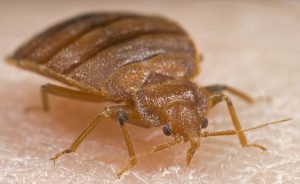 You may have heard about the emergence of bed bugs in larger cities such as Cincinnati and Columbus, but it is quickly becoming apparent to public health officials that the bigger cities are not the only ones being affected by these pests. Over the past month, Marion Public Health has received over a dozen phone calls about bed bugs and has positively identified several bed bugs.
You may have heard about the emergence of bed bugs in larger cities such as Cincinnati and Columbus, but it is quickly becoming apparent to public health officials that the bigger cities are not the only ones being affected by these pests. Over the past month, Marion Public Health has received over a dozen phone calls about bed bugs and has positively identified several bed bugs.
At first glance, this may not appear to be significant considering Marion County has a population of around 66,000 people. However, when you look at the trend in other cities, the numbers increase rapidly in a matter of a few years.
Bed bugs are external parasites that prefer to feed on humans. The bugs are similar in size to that of an apple seed and range in color from red to brown. Their bodies are oval shaped and are flattened when unfed and become swollen after feeding. As their name indicates, bed bugs have a tendency to live on mattresses, but they can be found anywhere in the home as they walk very fast and like to hide in thin cracks and crevices. They can be found high up in corners of ceilings, in draperies, behind pictures, and in electrical outlets. Currently, bed bugs are not known to transmit disease, but they can cause sleeplessness and anxiety in those living with them.
Also, currently, there is no inexpensive chemical or treatment approved to treat indoors. The chemicals that are out there do not work on the eggs. The eggs are attached with a strong glue like substance, making it impossible to vacuum them up. Therefore, it is up to the resident to follow certain steps to help eliminate them and to continue for a few months even after not seeing any live bugs.
Tips for preventing a bed bug infestation:
- Keep all beds pulled slightly away from walls, furniture, and curtains.
- Keep the floor under and around beds free of clutter.
- Use light colored sheets and pillowcases, and change them weekly. The mattress sheet should be elastic form-fitting or tucked under the mattress. Inspect for black fecal spots, small blood stains, shed skins, and live bugs when removing sheets.
- When traveling, carefully inspect hotel rooms and do not place any luggage, clothing, pillows, etc… on the floor of the room.
- When returning from a trip, inspect seams and pockets on suitcases and immediately wash all clothing in hot water.
- Only sleep on beds. Do not sleep on couches or in upholstered chairs.
- Inspect all used furniture and second hand clothing carefully for bed bugs before bringing them into the home.
Tips for treating a bed bug infestation:
- Contact a professional exterminator that has experience in treating for bed bugs.
- Do NOT throw away furniture or bedding that is in good condition. If you decide to get rid of the items, make sure that they are made unappealing so that others do not take them and infest their homes.
- Pillows and mattresses may be covered with plastic encasements. The encasements must remain on the items for at least a year since the bugs can live that long without food.
- Launder bedding and clothing in water over 120 degrees Fahrenheit, dry the items on a hot setting for more than 15 minutes, and bag the clean items so that further infestation cannot occur. Note: Bedbugs are killed by sustained temperatures under 15 degrees Fahrenheit and over 120 degrees Fahrenheit.
- Vacuum the seams of mattresses, cracks and crevices, around the carpet tack strips, and any other place where evidence of the bugs is found. The sweeper bag must be immediately removed from the dwelling and double bagged for trash pickup.
- Eliminate clutter. Successful treatment of bedbugs requires cooperation between landlords and tenants. It is every tenant’s responsibility to maintain his/her apartment in a clean and sanitary condition.
- Put a small amount of grease or Vaseline all the way around each of the bed legs just above the floor. Make sure the grease does not get on the floor. Alternatively, use double sided tape.
Some signs of a bed bug infestation include: welts on exposed skin, shed skins and eggshells, live bed bugs, and blood stains and black fecal spots on mattresses. The bites are painless and only some people experience allergic reactions to the bed bug saliva making the bite marks visible. Currently, bed bugs are not known to transmit disease, but they can cause sleeplessness and anxiety in those living with them.
Bed bugs can be found in a variety of environments. Examples include: dorms, apartments, houses, hotels, motels, and vehicles. They are considered to be good “hitchhikers” attaching to items such as clothing, shoes, luggage, and purses. Inspecting for an infestation when entering one of the previously mentioned environments is a vital step in preventing the spread of the bugs. Other preventative steps include: examining used furniture closely before bringing it home and checking clothes and luggage after traveling.
It is important to note that bed bugs are not caused by bad housekeeping nor are signs of uncleanliness; however, these conditions can make treating for the bugs difficult. If signs of bed bugs are found, contact a professional who has experience treating for the bed bugs. It is recommended that a second treatment is scheduled two weeks after the initial treatment as the bed bug eggs are difficult to remove. Continue treatments until the bed bugs are gone to prevent reinfestation. Chemicals are not generally recommended for mattresses or pillows unless the labels for the products indicate otherwise. These items may be covered with special encasements. The encasements must remain on the items for at least a year since the bugs may live that long without food. They may be found in department stores with the bedding items. Make sure to purchase one for the boxsprings also.
It is important to launder bedding and clothing in water over 120 degrees Fahrenheit, dry the items on a hot setting and allowing an extra 30 minutes on high after they are dry. Frequent vacuuming must also be done. Be sure to vacuum the seams of mattresses, cracks and crevices, around the carpet tack strips, and any other place where evidence of the bug is found. The sweeper bag must be immediately removed from the dwelling and double bagged for trash pick up. Infested items set out to the curb must be marked accordingly or made otherwise unappealing to prevent someone else from taking them and infesting additional areas. For more information about bed bugs, visit the OSU Extension’s website at ohioline.osu.edu/hyg-fact/2000/2105.html Information for businesses and professionals as well as public: www.centralohiobedbugs.org
Article by Marion Public Health Environmental Staff

